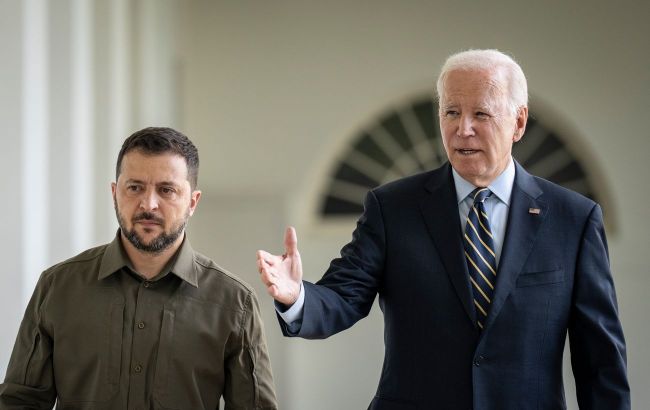Arms, financial, and humanitarian support: Aid Ukraine received from USA
 Archive photo: Volodymyr Zelenskyy and Joe Biden (Getty Images)
Archive photo: Volodymyr Zelenskyy and Joe Biden (Getty Images)
The United States has been supporting Ukraine since the first days of Russia's invasion. Over the course of more than two years of full-scale war, Washington has sent dozens of packages of military and humanitarian aid, as well as providing significant financial support.
More details on the assistance Ukraine received from the United States since February 24, 2022 - in the material by RBC-Ukraine.
During the preparation of the material, statements from President of Ukraine Volodymyr Zelenskyy, Prime Minister of Ukraine Denys Shmyhal, US Secretary of State Antony Blinken, US Secretary of Defense Lloyd Austin, US Secretary of the Treasury Janet Yellen, websites of the US Department of Defense, White House, US Department of State, the page of the US Ambassador to Ukraine Bridget Brink, Wikipedia, Bloomberg material, the Office of the Inspector General of the Pentagon, and the website of the Kyiv School of Economics were used.
Contents
Military assistance
The United States has provided military support to Ukraine since 2014, but the deliveries were not substantial. It was only in 2017 that former President Donald Trump approved the transfer of Javelin anti-tank complexes to the Armed Forces of Ukraine. In the run-up to the full-scale invasion, arms supplies from the United States became more frequent, and Ukraine began receiving small arms, Javelin, and Stinger complexes.
After the start of the full-scale invasion of Ukraine, arms deliveries from the United States sharply increased. For example, on February 26, 2022, US Secretary of State Antony Blinken approved $350 million in assistance to Ukraine. This included the transfer of anti-tank and anti-aircraft systems, small arms and ammunition of various calibers, body armor, and related equipment.
Supply of arms began to be carried out literally on a daily basis, and by the end of March 2022, US Secretary of Defense Lloyd Austin announced that Ukraine had received over $2 billion in assistance from the United States. In April, Ukraine received the first package of assistance, which included equipment of American production. This included M113 armored personnel carriers and 155mm M777 howitzers. At that time, Ukraine urgently needed the supply of Western artillery, as there was not enough of its own equipment to repel Russian aggression.
In the summer of 2022, the Ukrainian army began receiving High Mobility Artillery Rocket Systems (HIMARS) from the United States, which enabled them to strike at the enemy's rear positions. Many analysts pointed out that precise strikes on ammunition depots, command centers, and other important targets of the occupiers allowed to halt the advancement of Russian forces.
In addition, in the summer, the United States announced the transfer of the modern anti-aircraft missile system NASAMS to Ukraine. Furthermore, Ukraine received nearly 600 Phoenix Ghost strike and reconnaissance drones. Until winter, Ukraine continued to receive various assistance from the United States, including:
- MaxxPro armored vehicles;
- GMLRS rocket projectiles;
- High-precision ammunition M982 Excalibur;
- AGM-88 HARM anti-radiation missiles;
- M18A1 Claymore anti-personnel mines;
- M1117 armored personnel carriers;
- MIM-23 Hawk air defense systems;
- M1097 Avenger missile launchers.
In December 2022, the United States announced for the first time the transfer of Patriot missile system batteries to Ukraine in the latest PAC-3 modification. This system enabled the interception not only of cruise missiles but also ballistic missiles, which occupiers often used to target cities in Ukraine. Within a few months, the complex was delivered to Ukraine, and our soldiers shot down the first Iskander missile over Kyiv.
In January of last year, the United States took the unprecedented step of transferring M2 Bradley infantry fighting vehicles. Additionally, Washington decided to send Kyiv 155mm self-propelled howitzers M109A6 Paladin, Stryker armored personnel carriers, and M1 Abrams tanks.
A significant amount of armored vehicles was prepared for use by Ukrainian forces during the summer counteroffensive, but the Abrams tanks were only delivered to Ukraine in the fall. Their utilization was noted during the recent battles for Avdiivka in the Donetsk region.
In February of last year, the United States decided to transfer GLSDB missiles to Ukraine, which can target objects up to 150 km away. However, it was essentially about their production, which was delayed for almost a year. Only recently were they handed over to Ukrainian forces, and information about their use for strikes against occupiers was shared on social media. These missiles can be launched from HIMARS installations.
Throughout the spring and summer, Washington provided Kyiv with artillery ammunition, air defense systems, small arms, various types of drones, Stinger, TOW, and Javelin complexes. In the fall, long-range ballistic missiles ATACMS were delivered to Ukraine, which Ukrainian troops used to strike at airfields in the occupied cities of Berdyansk and Luhansk. The aviation equipment of the enemy was successfully hit there. However, the missiles were transferred in limited quantities, and new deliveries have not been announced yet.
At the end of December last year, the United States delivered the final package of aid and announced that they had run out of funds for new military shipments, as Congress had not approved President Joe Biden's request for additional funds to support Ukraine. However, within a few months, the US managed to find approximately $300 million more to provide Ukraine with the first military aid package for 2024. White House National Security Advisor Jake Sullivan clarified that this became possible due to cost-saving measures.
The US Congress has yet to approve new aid to Ukraine, which has affected the combat readiness of Ukrainian forces. American military assistance is crucial for the Armed Forces of Ukraine, as emphasized by President Volodymyr Zelenskyy. During the battles for Avdiivka, the Ukrainian army experienced a severe shortage of artillery shells, which was one of the reasons for withdrawing the garrison from the settlement.
In March, the USA launched a special website to oversee the spending of funds allocated to Ukraine. It indicates that since the beginning of the full-scale war, the USA has allocated 113.4 billion dollars in aid to Ukraine.
In December of last year, the Kiel Institute for the World Economy reported that the USA provided Ukraine with at least 43.9 billion euros in aid. That same month, President Zelenskyy announced that the USA had provided Ukraine with 21.6 billion euros in military assistance for 2023.
Financial support
The USA supports Ukraine not only militarily but also financially. The overall aid budget for Ukraine is allocated to specific areas, so a portion of the assistance is provided to Ukraine to support its economy, payments to teachers, internally displaced persons, or pensioners.
In September 2022, Prime Minister Denys Shmyhal reported that Ukraine received $4.5 billion from the USA from the World Bank's targeted fund. Last year, over $10 billion was allocated for financial support to Ukraine.
In January of this year, Treasury Secretary Janet Yellen stated that the USA aims to provide Ukraine with budgetary support totaling $11.8 billion. However, this support will be provided upon approval of the law on aid to Ukraine, which Congress has not yet approved. Some members of the Republican Party insisted that this aid should not be provided on a grant basis but in the form of a loan.
In February, the Bloomberg agency, citing a source, reported that Ukraine is developing a plan to obtain the necessary funds and cover the budget deficit in case financial assistance from the USA is blocked. The plan includes tax increases and expenditure reductions.
US humanitarian aid to Ukraine
Washington provides assistance to Ukraine that could be described as humanitarian support. For instance, in the summer of 2022, Secretary of State Blinken announced the allocation of nearly $400 million for humanitarian aid to Ukraine. Part of the assistance went through the United States Agency for International Development. This included food supplies, drinking water, cash assistance, affordable housing, and emergency medical aid.
In February of this year, it became known that the US government allocated over $2.6 billion in humanitarian aid to assist people affected by Russia's full-scale invasion of Ukraine.
The main part of humanitarian aid is used within Ukraine, but over $451 million was directed to meet the needs of refugees in Poland, Moldova, and other countries. The US allocated a portion of the funds to finance agencies such as:
- UN
- UNICEF
- UN High Commissioner for Refugees (UNHCR)
- International Organization for Migration (IOM)
- World Health Organization (WHO)
They provide humanitarian assistance within Ukraine. Additionally, Washington has allocated assistance in the energy sector so that Ukraine can repair infrastructure damaged by Russian attacks since the winter of 2022. This includes generators and high-voltage autotransformers.
The US also assists Ukraine in demining, providing necessary equipment to create more demining and sapper groups. Furthermore, Ukraine has received assistance from the US for investigating Russian war crimes; support from Americans has been passed on to law enforcement agencies.
Not long ago, the US Ambassador to Ukraine, Bridget Brink, announced the transfer of grain trucks to Kyiv. According to her, this will increase grain harvesting and unloading volumes, increasing throughput capacity by 31,400 tons per year, supporting Ukrainian farmers, agribusinesses, and the country's economy.

